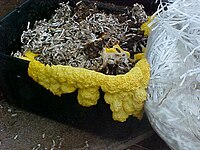
Photo from wikipedia
Three Bacillus amyloliquefaciens isolates (HK1, GSDM02, and GSDM15) were tested for effectiveness in biodegradation of plastic films. Isolates were screened by plate on carbon-free medium and by using the clear-zone… Click to show full abstract
Three Bacillus amyloliquefaciens isolates (HK1, GSDM02, and GSDM15) were tested for effectiveness in biodegradation of plastic films. Isolates were screened by plate on carbon-free medium and by using the clear-zone formation test. Their biodegradation ability was analyzed based on: film weight reduction, pH change of the fluid medium, a soil microbial biomass carbon test, scanning electron microscopy (SEM), and Fourier transform infrared spectrometry (FTIR). Polyvinyl alcohol (PVA) clear-zone and film weight reduction results revealed that the strain with a bigger clear-zone had a better biodegradation effect, that PVA can be evenly distributed in the medium, and that PVA can be a substitution for polyethylene in screening the biodegradation of strains. SEM and FTIR revealed that HK1 can tear the film apart and make surface chemical changes within 30 days. HK1 exhibited a better biodegradation effect in all tests, indicating its potential for helping solve the plastic pollution problems.
Journal Title: 3 Biotech
Year Published: 2018
Link to full text (if available)
Share on Social Media: Sign Up to like & get
recommendations!